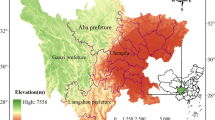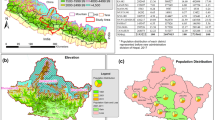Abstract
This study assessed changes in forest cover in a mountain watershed in central Nepal between 1976 and 2000 by comparing classified satellite images coupled by GIS analyses, and examined the association of forest change with major physiographic, economic, and local forest governance parameters. The results showed an increase in forested area (forest plus shrublands) by 7.6% during 1976–2000. Forest dynamism (changes including improvement, deterioration, gain, and loss) was highest in low-elevation, south-facing and less-steep slopes that were closer to roads. Proportionately the highest net improvement and gain to forested area also took place in those locations. Forest degradation occurred at twice the rate of improvement in high elevation areas (> 2300 m). Forests located in urban and semiurban areas (i.e., a market-oriented economy) experienced a proportionately higher amount of net improvement and gain than forests in rural areas (i.e., a subsistence economy). Among the three governance arrangements, proportionately the highest net improvement and gain took place in semigovernment forests (forested area legally under the forest department but with de facto control and claim of ownership by local communities and/or municipality) followed by formalized community forests (including leasehold). Government forests, which were mostly found in the southern high mountains and had virtually open access, remained relatively stable during the study period. Over 50% of the watershed forests have not come under community-based management despite favorable policy and more than two decades of government intervention with continuous donor support. The findings indicate that the present “one size fits all” approach of community forest handover policy in Nepal needs rethinking to accommodate biophysical and socioeconomic variations across the country.





Similar content being viewed by others
References
A. Agrawal E. Ostrom (2001) ArticleTitleCollective action, property rights, and decentralization in resource use in India and Nepal. Politics & Society 29 IssueID4 485–514
J. Anderson (2000) Four considerations for decentralized forest management: subsidiarity, empowerment, pluralism and social capital. T. Enters P. B. Durst M. Victor (Eds) Decentralization and devolution of forest management in Asia and the Pacific. RECOFTC Report No. 18 and RAP Publication 2000/1 Bangkok, Thailand 11–22
D. Bajracharya (1983) ArticleTitleFuel, food or forest? Dilemmas in a Nepali village. World Development 11 IssueID2 1057–1074 Occurrence Handle10.1016/0305-750X(83)90100-6
A. K. Banerjee (2000) Devolving forest management in Asia-Pacific countries. T. Enters P. B. Durst M. Victor (Eds) Decentralization and devolution of forest management in Asia and the Pacific. RECOFTC Report No. 18 and RAP Publication 2000/1 Bangkok, Thailand 39–52
A. G. Bartlett (1992) ArticleTitleA review of community forestry advances in Nepal. Commonwealth Forestry Review 71 IssueID2 95–100
S. Brown (1993) ArticleTitleTropical forests and global carbon cycle: the need for sustainable land-use patterns. Agriculture, Ecosystems and Environment 46 31–44
Dinerstein, E. 1998. A biodiversity assessment and gap analysis of the Himalayas. In Report on the International Meeting on Himalaya Ecoregional Co-operation, 16–18 February 1998, Kathmandu, Nepal. The United Nations Development Programme, pp. 157–161
C. M. Dongol K. F. D. Hughey H. R. Bigsby (2002) ArticleTitleCapital formation and sustainable community forestry in Nepal. Mountain Research and Development 22 IssueID1 70–77
ESCAP (Economic and Social Commission for Asia and the Pacific). 1997. Guidelines and manual on land-use planning and practices in watershed management and disaster reduction. ESCAP, United Nations, vii + 133 pp.
FAO (Food and Agriculture Organisation of the United Nations). 1997. Implementing sustainable forest management in Asia and the Pacific. Proceedings of a Regional Expert Consultation, Bangkok, 12–15 December 1995. RAP Publication: 1997/7. FAO, RAP, Bangkok, xiii + 246 pp.
R. J. Fisher P. B. Durst T. Enters M. Victor (2000) Overview of themes and issues in devolution and decentralization of forest management in Asia and the Pacific. T. Enters P. B. Durst M. Victor (Eds) Decentralization and devolution of forest management in Asia and the Pacific RECOFTC Report No. 18 and RAP Publication 2000/1 Bangkok, Thailand vi–xi
J. Fox J. Krummel S. Yarnasarn M. Ekasingh N. Podger (1995) ArticleTitleLand use and landscape dynamics in Northern Thailand: Assessing change in three upland watersheds. Ambio 24 3281–334
Gautam, A. P., 2002. Forest land use dynamics and community-based institutions in a mountain watershed in Nepal: Implications for forest governance and management. PhD dissertation. Asian Institute of Technology, Thailand, xi + 174 pp.
A. P. Gautam E. L. Webb (2001) ArticleTitleSpecies diversity and forest structure of pine plantations in the Middle Hills of Nepal. Banko Jankari 11 IssueID2 131–21
A. P. Gautam E. L. Webb A. Eiumnoh (2002) ArticleTitleGIS assessment of land use/land cover changes associated with community forestry implementation in the Middle Hills of Nepal. Mountain Research and Development 22 IssueID1 63–69
C. Gibson M. A. McKean E. Ostrom (2000) People and forests: communities, institutions, and governance. The MIT Press Cambridge, Massachusetts xxiv + 274 pp
D. A. Gilmour R. J. Fisher (1991) Villagers, forests and foresters. Sahayogi Press Kathmandu, Nepal xxiii +212 pp
HMGN (His Majesty’s Government of Nepal). 1995. Forest Regulation, 1995 (official translation). HMGN, Ministry of Forest and Soil Conservation, Kathmandu, 24 pp.
ICIMOD (International Centre for Integrated Mountain Development). 1994. Application of GIS in rural development planning in Nepal. MENRIS Case Study Series No. 2, ICIMOD, Kathmandu, Nepal, 84 pp.
J. K. Jackson (1994) Manual of afforestation in Nepal, 2 Vol. Forest Research and Survey Centre Kathmandu, Nepal xvi + 824 pp
W. J. Jackson M. C. Nurse R. B. Chhetri (1993) ArticleTitleHigh altitude forests in the Middle Hills: can they be managed as community forests? Banko Janakari 4 IssueID1 20–23
W. J. Jackson R. M. Tamrakar S. Hunt K. R. Shepherd (1998) ArticleTitleLand-use changes in two Middle Hill districts of Nepal. Mountain Research and Development 18 IssueID3 193–212
JTRCF (Joint Technical Review of Community Forestry). 2001. JTRCF: Report of the Joint Technical Review Committee. Ministry of Forest and Soil Conservation, Kathmandu, Nepal, ix + 48 pp.
J. Kammerbauer C. Ardon (1999) ArticleTitleLand use dynamics and landscape change pattern in a typical watershed in the hillside region of central Honduras. Agriculture. Ecosystems and Environment 75 931–100 Occurrence Handle10.1016/S0167-8809(99)00071-7
K. R. Kanel (1997) Community forestry: implications for watershed management. C. B. Khenmark L. Thaiuts L. Puangchit S. Thammincha (Eds) Proceedings of the FORTROP’ 96: Tropical Forestry in the 21st Century, 25–28 November 1996. Kasetsart University Bangkok, Thailand 146–171
N. Kumar (2000) ArticleTitleAll is not green with JFM in India. Forest, Trees and People Newsletter 42 461–50
E. Ligon U. Narain (1999) ArticleTitleGovernment management of village commons: comparing two forest policies. Journal of Environmental Economics and Management 37 2721–289 Occurrence Handle10.1006/jeem.1999.1066
T. B. S. Mahat D. M. Griffin K. R. Shepherd (1986) ArticleTitleHuman impact on some forests of the Middle Hills of Nepal, Part 2. Some major human impacts before 1950 on forests of Sidhu Palchok and Kabhre Palanchok. Mountain Research and Development 6 3251–334
H. Nagendra (2002) ArticleTitleTenure and forest conditions: community forestry in the Nepal Terai. Environmental Conservation 29 IssueID4 530–539 Occurrence Handle10.1017/S0376892902000383
P. X. Phuong (2000) People’s participation in forest management in Vietnam. T. Enters P. B. Durst M. Victor (Eds) Decentralization and devolution of forest management in Asia and the Pacific. RECOFTC Report No. 18 and RAP Publication 2000/1 Bangkok, Thailand 87–93
P. P. Pravongviengkham (2000) A national advocacy for a holistic and decentralized approach to forest management in Lao PDR. T. Enters P. B. Durst M. Victor (Eds) Decentralization and devolution of forest management in Asia and the Pacific. RECOFTC Report No. 18 and RAP Publication 2000/1 Bangkok, Thailand 75–86
Pokharel, B. K. 1997. Foresters and villagers in contention and compact. PhD dissertation University of East Anglia, Norwich, UK, vi + 426 pp.
J. A. Richards (1994) Remote sensing digital image analysis: an introduction. 2, revised and enlarged ed. Springer-Verlag Berlin 340
H. Schreier S. Brown M. Schmidt P. Shah B. Shrestha G. Nakarmi K. Subba S. Wymann (1994) ArticleTitleGaining forest but losing ground: a GIS evaluation in a Himalayan watershed. Environmental Management 18 IssueID1 139–150
C. M. Schweik K. Adhikari K. N. Pandit (1997) ArticleTitleLand cover change and forest institutions: a comparison of two sub-basins in the southern Siwalik Hills of Nepal. Mountain Research and Development 17 991–116
Singh, B. K., and B. B. Shrestha. 2000. Status of leasehold groups and leasehold sites. RAPR: GCP/NEP/052/NET, Field Document 05/2000, Food and Agriculture Organisation of the United Nations, Kathmandu, 34 pp.
Sterk, A. 1998. Leasing degraded forest land: An innovative way to integrate forest and livestock development in Nepal. Food and Agriculture Organisation of the United Nations, Regional Office for Asia and the Pacific, Bangkok, Thailand, 49 pp.
K. Tekle L. Hedlund (2000) ArticleTitleLand cover changes between 1958 and 1986 in Kalu district, Southern Wello, Ethiopia. Mountain Research and Development 20 42–51
P. M. Teillet B. Guindon D. G. Goodenough (1982) ArticleTitleOn the slope-aspect correction of multi-spectral scanner data. Canadian Journal of Remote Sensing 8 841–106
Varughese G. 1999. Villagers, bureaucrats, and forests in Nepal: Designing governance for a complex resource. PhD thesis. Indiana University, Indiana, xii + 229 pp.
G. Varughese E. Ostrom (2001) ArticleTitleThe contested role of heterogeneity in collective action: some evidences from community forestry in Nepal. World Development 29 IssueID5 747–765 Occurrence Handle10.1016/S0305-750X(01)00012-2
K. J. Virgo K. J. Subba (1994) ArticleTitleLand-use change between 1978 and 1990 in Dhankuta District, Koshi Hills, Eastern Nepal. Mountain Research and Development 14 1591–170
E. L. Webb A. P. Gautam (2001) ArticleTitleEffects of community forest management on the structure and diversity of a successional broadleaf forest in Nepal. International Forestry Review 3 IssueID2 146–157
E. L. Webb M. Khurshid (2000) ArticleTitleDivergent destinies among pine forests in northern Pakistan: linking ecosystem characteristics with community self-governance and local institutions. International Journal of Sustainable Development and World Ecology 7 1891–200
Acknowledgments
Financial support for this research was provided by DANIDA through a doctoral research grant to Ambika Gautam under the Integrated Watershed Development and Management program of the Asian Institute of Technology, ANUTECH Pty Ltd., Australia, through the Nepal Australia Community Resource Management Project, and a MacArthur postdoctoral research grant made available to Ambika Gautam through The Workshop in Political Theory and Policy Analysis at Indiana University. We thank the Center for the Study of Institutions, Population, and Environmental Change at Indiana University for sharing Landsat satellite imagery from 1976. The authors would also like to thank Dr. Charles M. Schweik, University of Massachusetts, and two anonymous reviewers for valuable comments on an earlier version of this paper.
Author information
Authors and Affiliations
Rights and permissions
About this article
Cite this article
Gautam, A., Shivakoti, G. & Webb, E. Forest Cover Change, Physiography, Local Economy, and Institutions in a Mountain Watershed in Nepal . Environmental Management 33, 48–61 (2004). https://doi.org/10.1007/s00267-003-0031-4
Published:
Issue Date:
DOI: https://doi.org/10.1007/s00267-003-0031-4




